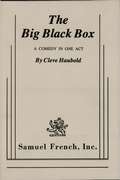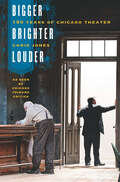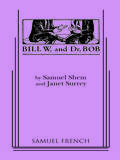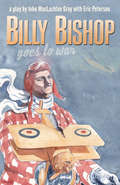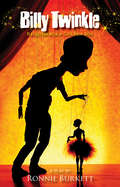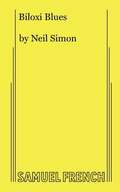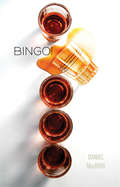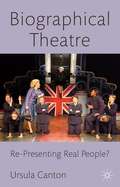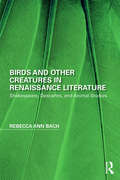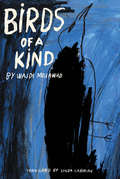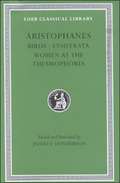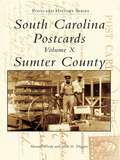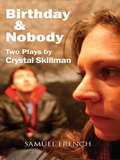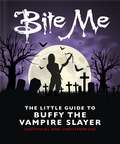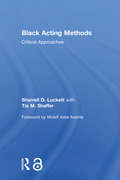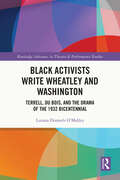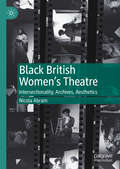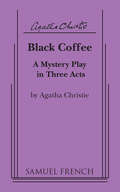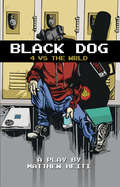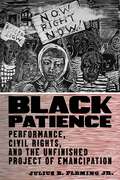- Table View
- List View
Big Black Box
by Cleve HauboldComedy / 1m, plus 1 offstage voice / In this frighteningly funny parable of a modern man who puts all of his eggs into the wrong basket and then falls into that basket, the gullible Arnold is lured into conversation with a mysterious black box. The box tricks him out of his possessions and ultimately uses them to ensnare him. Arnold nearly escapes, but the box plays on his weaknesses to trap him inescapably. FEE: $35 per performance.
Bigger, Brighter, Louder: 150 Years of Chicago Theater as Seen by "Chicago Tribune" Critics
by Chris JonesThe first known Chicago Tribune theater review appeared on March 25, 1853. An anonymous notice, it shared the page with two other announcements--one about a pair of thousand-pound hogs set to be slaughtered and another trumpeting the largest load of lumber ever to leave Chicago. "And thus Chicago's priorities were starkly laid out right there on that page," begins Chris Jones in the introduction to this eyewitness cultural history. "Hog butcher for the world and windy self-promoter, specializing in commerce-driven superlatives. The arts came a poor third. Critics, and the artists they covered, would rail against that perceived set of civic priorities for years. " The Chicago of today, on the other hand, is regarded as one of the world's premier cities for theater, and no one has had a more consistent front-row seat to its ascendance than the Chicago Tribune theater critics. Bigger, Brighter, Louder weaves together more than 150 years of Tribune reviews into a compelling narrative, pairing full reviews with commentary and history. With a sharp eye for telling details and a keen sense of historical context, Jones, longtime chief Tribune theater critic, takes readers through decades of highs and lows, successes and failures. The book showcases fascinating early reviews of actors and shows that would go on to achieve phenomenal success, including a tryout of A Raisin in the Sun with newcomer Sidney Poitier and the first major review of The Producers. It also delves into the rare and the unusual, such as a previously unpublished Tennessee Williams interview and a long conversation with Edward Albee's mother. With reviews from Claudia Cassidy, Peregine Pickle, William Leonard, and more, many never collected before, Bigger, Brighter, Louder offers a unique lasting record of an ephemeral art and a riveting look at the history behind Chicago's rise to theatrical greatness.
Bill W. and Dr. Bob
by Samuel Shem Janet SurreyDrama / 3m, 3f (w/doubling) / Unit set Newly revised edition! From the author of the best-selling novel, The House of God, this critically acclaimed version which played Off-Broadway in 2007, tells the amazing story of the two men who pioneered Alcoholics Anonymous, and of their wives, who founded Al Anon. During the roaring '20s, New York stockbroker Bill Wilson rides high on money, fame, and booze. In '29, both he and the market crash and he becomes a hopeless drunk. Dr. Bob Smith, a surgeon in Akron, Ohio, and a pillar of the community, has been a secret drunk for thirty years, often going into the operating room hungover and high on sedatives. His family has tried everything to no avail. Through an astonishing series of events involving doctors, ministers, the Oxford Group evangelical movement, and Henrietta Sieberling a scion of the Goodyear Rubber fortune, Bill and Bob meet on Mother's Day of 1935. The two men form a relationship which keeps each sober. Fired up, they seek out a third drunk to see if their program will work for others. Richly textured with the ragtime and jazz of the era, the play tells a magnificent American success story. "A deeply human, audience embracing tale." - Variety "One of the best plays of the year." - San Diego Union Tribune "Inspiring." - Boston Globe
Billy Bishop Goes to War
by John Gray Eric PetersonOne of Canada's most successful and enduring musical plays, Billy Bishop Goes to War was first published in 1982 and went on to win the Los Angeles Drama Critics' Award and the Governor General's Award for Drama. In 2010, the celebrated story of the World War I flying ace - credited with seventy-two victories and billed as the top pilot in the British Empire - was revised to frame the original play as a retrospective. It is the same play it always was - the difference is in the telling. Billy Bishop now appears in his later years, reflecting on his wartime exploits, and on the business of war and hero making. Bishop's reminiscence is not so much about the horror and death of war as it is about being young and intensely alive. "The prime of life / The best of men," Bishop sings, "It will never be / Like this again."A memory play about war, Billy Bishop has been going into battle onstage for more than thirty years. The Canadian classic is revisited in this second edition, where war is still a terrible thing, but some men say it was the greatest time of their lives. It's about the ironies and the price of survival.The play format is deceptively simple with a solo narrator who assumes multiple roles while his piano-playing sidekick offers sardonic musical comments.Cast of 2 men.
Billy Twinkle: Requiem for a Golden Boy
by Ronnie BurkettStanding at the edge of the ship, contemplating a watery demise, Billy is called back to reality when his dead mentor Sid Diamond appears as a handpuppet. Sid forces Billy to re-enact his life as a puppet show, rekindling the passion Billy once had for puppets, people, and the dream of a life that sparkles. For anyone stuck in the middle—mid-career, mid-love, mid-life—this requiem for a golden boy shines a little light on the wonder of youth meeting the wisdom of age.
Biloxi Blues: A New Comedy
by Neil SimonFull Length, Comic Drama / Casting: 6m, 2f / Scenery: Various sets, Tony Award Best Play 1985. <p><p> The second in Pulitzer Prize-winning playwright Neil Simon's trilogy which began with Brighton Beach Memoirs and concluded with Broadway Bound. When we last met Eugene Jerome, he was coping with adolescence in 1930's Brooklyn. Here, he is a young army recruit during WW II, going through basic training.
Bingo!
by Daniel MacivorFive classmates come together for their thirtieth high-school reunion. Some see it as a welcome trip home, while others see it as an obligation, and a few never even left. But as the night wears on, the one-time classmates start to reconnect and reminisce. And the more alcohol that’s consumed the closer the friends come to confronting their darkest secrets. Once again, Daniel MacIvor proves to us that just because we’re all grown up doesn’t mean we have everything figured out. His characters are sometimes naive, often crass, but always honest. As they try to reclaim their high-school glory days, these five friends charge headfirst into the secrets they all tried to run so far from.
Biographical Theatre
by Ursula CantonMarilyn Monroe, Vincent van Gogh or the victims of rendition flights - the number and variety of historical and contemporary figures represented on British stages is amazing. This book develops a new theoretical framework for the representation of real life figures on stage and examines different ways in which they can be included in performances.
Birds and Other Creatures in Renaissance Literature: Shakespeare, Descartes, and Animal Studies (Perspectives on the Non-Human in Literature and Culture)
by Rebecca Ann BachThis book explores how humans in the Renaissance lived with, attended to, and considered the minds, feelings, and sociality of other creatures. It examines how Renaissance literature and natural history display an unequal creaturely world: all creatures were categorized hierarchically. However, post-Cartesian readings of Shakespeare and other Renaissance literature have misunderstood Renaissance hierarchical creaturely relations, including human relations. Using critical animal studies work and new materialist theory, Bach argues that attending closely to creatures and objects in texts by Shakespeare and other writers exposes this unequal world and the use and abuse of creatures, including people. The book also adds significantly to animal studies by showing how central bird sociality and voices were to Renaissance human culture, with many believing that birds were superior to some humans in song, caregiving, and companionship. Bach shows how Descartes, a central figure in the transition to modern ideas about creatures, lived isolated from humans and other creatures and denied ancient knowledge about other creatures’ minds, especially bird minds. As significantly, Bach shows how and why Descartes’ ideas appealed to human grandiosity. Asking how Renaissance categorizations of creatures differ so much from modern classifications, and why those modern classifications have shaped so much animal studies work, this book offers significant new readings of Shakespeare’s and other Renaissance texts. It will contribute to a range of fields, including Renaissance literature, history, animal studies, new materialism, and the environmental humanities.
Birds of a Kind
by Wajdi MouawadIs it really important to cling to our lost identities? A terrorist attack in Jerusalem puts Eitan, a young Israeli-German genetic researcher, in a coma, while his girlfriend Wahida, a Moroccan graduate student, is left to uncover his family secret that brought them to Israel in the first place. Since Eitan’s parents erupted at a Passover meal when they realized Wahida was not Jewish, he has harboured a suspicion about his heritage that, if true, could change everything. In this sweeping new drama from the prolific Wajdi Mouawad, the Israeli-Palestinian conflict hits close to home as a straitlaced family is forced to confront everything they know about their identities.
Birds, Lysistrata, Women at the Thesmophoria
by Aristophanes Jeffrey HendersonAristophanes (c. 450 c. 386 BCE) has been admired since antiquity for his wit, fantasy, language, and satire. The protagonists of Birds create a utopian counter-Athens. In Lysistrata wives go on conjugal strike until their husbands end war. Women in Women at the Thesmophoria punish Euripides for portraying them as wicked.
Birmingham's Theater and Retail District (Images of America)
by Tim HollisFrom the 1890s to the 1970s, the thriving area of Birmingham between Eighteenth and Twenty-first Streets along First, Second, and Third Avenues was the bustling heart of this quickly growing city. Before the age of the shopping mall, the downtown was the center of retail and entertainment in Birmingham. Along these streets, entrepreneurial immigrants built department stores--including Pizitz and Loveman, Joseph, and Loeb--while the marquees of the Alabama, Ritz, and Lyric theaters, among others, shined over the busy downtown sidewalks.
Birthday And Nobody
by Crystal SkillmanCollection of two plays. In Birthday, an anxious young woman slips away from a unwelcoming birthday party in a bar only to discover a stranger sitting in the other room. Confiding old secrets and past mistakes as the party rages nearby, they find they may have a chance to forgive themselves and each other. In Nobody six people come together, each for their own reasons, at a restaurant on the Lower East Side. Obsessively going over the events of the day, they grasp at trying to come to terms with their disjointed lives and their singular, unsettling dream.
Bite Me: The Little Guide to Buffy the Vampire Slayer
by Orange Hippo!"I'm Buffy, the vampire slayer. And you are?"A prestige show that was ahead of its time, Buffy the Vampire Slayer brought vampires back into the mainstream and made stars of its cast, and its impact has lasted long after the show's end. With its unique blend of high-school drama, witty banter and the supernatural, Buffy the Vampire Slayer became known for ushering in golden age of television. With a devoted cult following and a growing new audience, Buffy remains a cultural icon.Reminisce some of the most iconic quotes you've ever heard in your life (or "unlife") in The Little Guide to Buffy the Vampire Slayer, filled with quips and facts about the adventures of the famous slayer and her friends against the forces of darkness."In every generation, there is a chosen one. She alone shall stand against the vampires, demons and forces of darkness. She is the slayer."Spike's trademark coat cost $2,000 from a top fashion store. It was then run over repeatedly by a truck to give it that distressed look.
Bite Me: The Little Guide to Buffy the Vampire Slayer
by Orange Hippo!"I'm Buffy, the vampire slayer. And you are?"A prestige show that was ahead of its time, Buffy the Vampire Slayer brought vampires back into the mainstream and made stars of its cast, and its impact has lasted long after the show's end. With its unique blend of high-school drama, witty banter and the supernatural, Buffy the Vampire Slayer became known for ushering in golden age of television. With a devoted cult following and a growing new audience, Buffy remains a cultural icon.Reminisce some of the most iconic quotes you've ever heard in your life (or "unlife") in The Little Guide to Buffy the Vampire Slayer, filled with quips and facts about the adventures of the famous slayer and her friends against the forces of darkness."In every generation, there is a chosen one. She alone shall stand against the vampires, demons and forces of darkness. She is the slayer."Spike's trademark coat cost $2,000 from a top fashion store. It was then run over repeatedly by a truck to give it that distressed look.
Black Acting Methods: Critical Approaches
by Sharrell Luckett Tia M. ShafferBlack Acting Methods seeks to offer alternatives to the Euro-American performance styles that many actors find themselves working with. A wealth of contributions from directors, scholars and actor trainers address afrocentric processes and aesthetics, and interviews with key figures in Black American theatre illuminate their methods. This ground-breaking collection is an essential resource for teachers, students, actors and directors seeking to reclaim, reaffirm or even redefine the role and contributions of Black culture in theatre arts.
Black Activists Write Wheatley and Washington: Terrell, Du Bois, and the Drama of the 1932 Bicentennial (Routledge Advances in Theatre & Performance Studies)
by Lurana Donnels O’MalleyThis book examines how early twentieth-century Black theatre artists depicted national mythologies of the United States.White-authored pageants and plays written for the 1932 Bicentennial celebration of George Washington’s birthday relegated Black Americans to the periphery through racist stereotyping. Black activists Mary Church Terrell and W. E. B. Du Bois seized the opportunity to place Black people at center stage and to revise contemporary views of Washington and of Black achievement. Terrell’s Historical Pageant-Play Based on the Life of Phyllis Wheatley and Du Bois’s George Washington and Black Folk dramatize how the achievements of Black men and women fit into the US origin story. Terrell’s script is a biography of the life of the enslaved African poet Phillis Wheatley; Du Bois’s pageant is a transgressive revision of the Washington myth.The book’s chapters contextualize these plays within the larger Bicentennial event. O’Malley also includes her edited version of Terrell’s script, published here for the first time.This interdisciplinary book will be a valuable resource for college and university courses in American theatre and performance studies, Black Studies, and Women’s Studies.
Black British Women's Theatre: Intersectionality, Archives, Aesthetics
by Nicola AbramThis book marks a significant methodological shift in studies of black British women’s theatre: it looks beyond published plays to the wealth of material held in archives of various kinds, from national repositories and themed collections to individuals’ personal papers. It finds there a cache of unpublished manuscripts and production recordings distinctive for their non-naturalistic aesthetics. Close analysis of selected works identifies this as an intersectional feminist creative practice. Chapters focus on five theatre companies and artists, spanning several decades: Theatre of Black Women (1982-1988), co-founded by Booker Prize-winning writer Bernardine Evaristo; Munirah Theatre Company (1983-1991); Black Mime Theatre Women’s Troop (1990-1992); Zindika; and SuAndi. The book concludes by reflecting on the politics of representation, with reference to popular postmillennial playwright debbie tucker green. Drawing on new interviews with the playwrights/practitioners and their peers, this book assembles a rich, interconnected, and occasionally corrective history of black British women’s creativity. By reproducing 22 facsimile images of flyers, production programmes, photographs and other ephemera, Black British Women’s Theatre: Intersectionality, Archives, Aesthetics not only articulates a hidden history but allows its readers their own encounter with the fragile record of this vibrant past.
Black Coffee
by Agatha ChristieFull Length Play / Dramatic Comedy, Mystery Thriller / 10m, 3f / Interior Set. This little known mystery will surprise and delight Christie fans. The story concerns a physicist named Sir Claude Amory who has come up with a formula for an atom bomb (Black Coffee was written in 1934!). In the first act, Sir Claude is poisoned (in his coffee, naturally) and Hercule Poirot is called in to solve the case. He does so after many wonderful twists and turns in true Christie tradition.
Black Diva of the Thirties: The Life of Ruby Elzy (Willie Morris Books in Memoir and Biography)
by David E. WeaverWhile undergoing routine surgery to remove a benign tumor, Ruby Elzy died. She was only thirty-five. Had she lived, she would have been one of the first Black artists to appear in grand opera. Although now in the shadows, she was a shining star in her day. She entertained Eleanor Roosevelt in the White House. She was Paul Robeson's leading lady in the movie version of The Emperor Jones. She starred in Birth of the Blues opposite Bing Crosby and Mary Martin. She sang at Harlem's Apollo Theater and in the Hollywood Bowl. Her remarkable soprano voice was known to millions over the radio. She was personally chosen by George Gershwin to create one of the leading roles in his masterpiece, that of Serena in the original production of Porgy and Bess. Her signature song was the vocally demanding “My Man's Gone Now.” From obscurity she had risen to great heights. Ruby Pearl Elzy (1908-1943) was born in abject poverty in Pontotoc, Mississippi. Her father abandoned the family when she was five, leaving her mother, a strong, devout woman, to raise four small children. Ruby first sang publicly at the age of four and even in childhood dreamed of a career on the stage. Good fortune struck when a visiting professor, overwhelmed upon hearing her beautiful voice at Rust College in Mississippi, arranged for her to study music at Ohio State University. Later, on a Rosenwald Fellowship, she enrolled at the Juilliard School in New York City. After more than eight hundred performances in Porgy and Bess, she set her sights on a huge goal, to sing in grand opera. She was at the peak of her form. While she was preparing for her debut in the title role of Verdi's Aida, tragedy struck. During her brief career, Ruby Elzy was in the top tier of American sopranos and a precursor who paved a way for Leontyne Price, Jessye Norman, Kathleen Battle, and other black divas of the operatic stage. This biography acknowledges her exceptional talent, recognizes her contribution to American music, and tells her tragic yet inspiring story.
Black Dog: 4 vs the wrld
by Matthew HeitiThe Breakfast Club meets Shirley Jackson in a fusion of live theatre and technology that tells a darkly comic but hopeful story of four teenage outsiders struggling with death, depression and the shadow of a black dog. Two is fraught. While dealing with the impossible expectations of her parents, she is trying to understand why her brother, a bright and talented teenager, has taken his own life. It’s not until a fateful school detention that she meets three other students who all seem as lost as she is. There’s Three, a quiet, misunderstood guy who doesn’t quite know how to care for himself; Four, the fashionable, popular kid and class clown; and Five, a rebel ready to fight against everyone and everything. Despite their differences, they each grapple with depression and anxiety and become an unlikely source of comfort to one another. As the four unite to battle teachers, parents, therapists and their own demons, their promising futures begin to reveal themselves.
Black Jack
by Rosary Hartel O'NeillFull Length, Southern Comedy CharacterS: 2 male, 4 female. Unit Set. Blackjack follows an eccentric Southern family as it is squeezed into the close quarters of a Mississippi cruise ship for the New Year's holiday. Kaitlyn is convinced that she is channeling the poet Baudelaire, and certain that her husband is having an affair with a larger-than-life ship entertainer. Irene, the matriarch of the family, suspects a rift in her daughter's marriage. Her sexy maid sets her sights on the grandson, a successful Southern rock star. Everyone dons costumes for New Year's Eve, casting off their old identities and trying on new loves. . Also available in A Louisiana Gentleman and other New Orleans Comedies
Black Patience: Performance, Civil Rights, and the Unfinished Project of Emancipation (Performance and American Cultures)
by Julius B. Fleming Jr.Honorable Mention, 2024 Callaway Prize for the Best Book on Drama, Theatre, and Performance Studies (New York University)2024 College Language Association Book Award Winner2023 Hooks National Book Award Winner (Benjamin L. Hooks Institute for Social Change)Honorable Mention, Association for the Study of the Arts of the Present 2023 Book PrizeHonorable Mention, 2023 John W. Frick Book Award (American Theatre and Drama Society)Finalist, 2022 George Freedley Memorial Award of the Theatre Library Association.Finalist, Barnard Hewitt Award for Outstanding Research in Theatre History (ASTR)Finalist, ATHE Outstanding Book AwardA bold rethinking of the Civil Rights Movement through the lens of Black theater“Freedom, Now!” This rallying cry became the most iconic phrase of the Civil Rights Movement, challenging the persistent command that Black people wait—in the holds of slave ships and on auction blocks, in segregated bus stops and schoolyards—for their long-deferred liberation. In Black Patience, Julius B. Fleming Jr. argues that, during the Civil Rights Movement, Black artists and activists used theater to energize this radical refusal to wait. Participating in a vibrant culture of embodied political performance that ranged from marches and sit-ins to jail-ins and speeches, these artists turned to theater to unsettle a violent racial project that Fleming refers to as “Black patience.” Inviting the likes of James Baldwin, Lorraine Hansberry, Alice Childress, Douglas Turner Ward, Duke Ellington, and Oscar Brown Jr. to the stage, Black Patience illuminates how Black artists and activists of the Civil Rights era used theater to expose, critique, and repurpose structures of white supremacy. In this bold rethinking of the Civil Rights Movement, Fleming contends that Black theatrical performance was a vital technology of civil rights activism, and a crucial site of Black artistic and cultural production.
Black Playwrights and Heightened Text: When Shakespeare Ain’t Enuf
by Jacqueline SpringfieldBlack Playwrights and Heightened Text: When Shakespeare Ain’t Enuf breaks down the misconception that heightened text sits only within a white tradition and brings the work of Black playwrights from across history to the forefront by highlighting the use of heightened dramatic text in their work.Interrogating the use of linguistic techniques often seen in heightened text, such as: enjambment, assonance, and consonance, author Jacqueline Springfield looks at the ways in which these techniques allow the text itself to have a kind of permanence in audiences’ minds and works to reinforce a character’s objective within the play. The book presents examples of works from a plethora of Black playwrights, including Langston Hughes, Lorraine Hansberry, Amiri Baraka, August Wilson, Katori Hall, Marcus Gardley, Tarell Alvin McCraney, and many more, as well as providing the context in which they’re writing. Theatre artists who read, teach, direct and perform the work of Black playwrights answer key questions in their own words in interviews with the author. Interviewees include Dominique Morisseau, Ron OJ Parson, Mfoniso Udofia, Zora Howard and many other theatre practitioners. Taking a chronological approach, the book examines the history of heightened text in the works of Black playwrights and re-defines the ways in which theatre students and scholars can understand the techniques of heightened texts outside of a purely Eurocentric and white perspective.Ideal for students of theatre history, acting, playwriting, and text analysis, as well as researchers of African American theatre.
